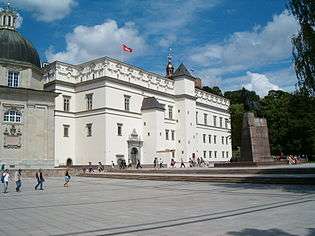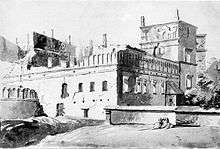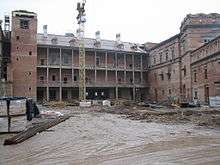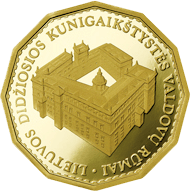Palace of the Grand Dukes of Lithuania


Upper Castle: 1. Western tower; 2. Southern tower (foundations remaining); 3. Palace (ruins remaining)
Lower Castle: 4. Gates and bridge to the city (Pilies Street); 5. Road and bridge to a Tilto street; 6. Cathedral; 7. Palace of Supreme Tribunal; 8. Palace of bishops; 9. Royal Palace; 10. Palace garden; 11. Palace building, arsenal since the late 18th century, currently museum; 12. North-eastern tower and gates of arsenal; 13. Yard of arsenal
The Palace of the Grand Dukes of Lithuania[1] (Lithuanian: Lietuvos Didžiosios Kunigaikštystės valdovų rūmai Vilniaus žemutinėje pilyje; Polish: Zamek Dolny w Wilnie) is a palace in Vilnius, Lithuania. It was originally constructed in the 15th century for the rulers of the Grand Duchy of Lithuania and the future Kings of Poland. The palace, located in the lower castle of Vilnius, evolved over the years and prospered during the 16th and mid-17th centuries. For four centuries the palace was the political, administrative and cultural centre of the Polish–Lithuanian Commonwealth. It was demolished in 1801. Work on a new palace started in 2002 on the site of the original building, and it was opened on 6 July 2009.
History
.jpg)

In the 13th and 14th centuries there were stone structures within the palace site; some archaeologists believe that a wooden palace stood there as well. The stone palace was built in the 15th century, apparently after a major fire in 1419. The existing stone buildings and defensive structures of the lower castle, which blocked the construction, were demolished. The palace was built in Gothic style. The keep of the upper castle, as well as the palace, were meant to host the coronation of Vytautas the Great. The Gothic palace had three wings; research suggests that it was a two-story building with a basement.[2]
Grand Duke Alexander Jagiellon, who later became King of Poland, moved his residence to the palace, where he met with ambassadors. He ordered the renovation of it. After his marriage to a daughter of Moscow's Grand Duke Ivan III, the royal couple lived and died in there.
Sigismund I the Old, after his ascension to the grand ducal throne, conducted his affairs in the palace as well as in Vilnius Cathedral. During the rule of Sigismund I the palace was greatly expanded to meet the new needs of the grand duke. Another wing was added, as well as a third floor, and the gardens were extended. By contemporary accounts the palace was worth 100,000 ducats.[3] The palace reconstruction plan was probably prepared by the Italian architect Bartolomeo Berrecci da Pontassieve, who also designed several other projects in the Kingdom of Poland. In this palace Sigismund the Old welcomed an emissary from the Holy Roman Empire, who introduced Sigismund to Bona Sforza, his second wife, in 1517.
Sigismund's son Sigismund II Augustus was crowned Grand Duke of Lithuania in the palace. Sigismund II carried on with the development work and lived there with his first wife Elisabeth of Austria, daughter of Ferdinand I, Holy Roman Emperor. She was laid to rest in Vilnius Cathedral.[4] Sigismund II's second wife, Barbara Radziwiłł, also lived in the palace. According to contemporary accounts of the Holy See's emissary, the palace at that time contained more treasures than the Vatican.[5] Sigismund II also assembled one of the largest collection of books and tapestries in Europe.[5]

The palace was remodelled in the Renaissance style in the 16th century. The plan was prepared by several Italian architects, including Giovanni Cini da Siena, Bernardino de Gianotis Zanobi, and others. The palace was visited by Ippolito Aldobrandini, who later became Pope Clement VIII. Another major development took place during the reign of the House of Vasa. The palace was refurbished in the early Baroque style during the rule of Sigismund III Vasa. Matteo Castello, Giacopo Tencalla, and other artists participated in the 17th-century renovation.
During the Vasa rule, several notable ceremonies took place, including the wedding of Duke John, who later became King John III of Sweden, and Sigismund Augustus' sister Catherine. The first opera in Lithuania was staged in the palace in 1634.[6] Marco Scacchi and Virgilio Puccitelli were the opera's impresarios.
.jpg)
After the Russian invasion in 1655, the state began to weaken, and that also affected the castle. In August 1655, Vilnius was captured by the Muscovite army. The Polish army recaptured the city six years later, by which time the palace had been destroyed by fire. The palace was greatly damaged and its treasures were plundered. After the recapture of the city of Vilnius in 1660–1661, the palace was no longer a suitable state residence, and stood abandoned for about 150 years. In the late 18th century, after the fall of the Polish–Lithuanian Commonwealth, several families lived in parts of the ruined palace. Soon after the Grand Duchy of Lithuania was incorporated into Tsarist Russia, officials ordered the demolition of the remaining sections of the palace.[6] The structure was almost completely demolished in 1801, the bricks and stones were sold, and the site was bowered.

Only a small portion of the walls up to the second floor survived, that were sold to the Jewish merchant Abraham Schlossberg around 1800, who incorporated them into his house. After the November Uprising of 1831, the czarist government expelled Schlossberg and took over the building, as it was building a fortress beside it.
After Lithuania regained its independence following World War I in 1918, the castle became the headquarters of the army. It soon was captured by Polish troops following the Polish annexation of Vilnius (Wilno). During World War II, it was the office of the German Wehrmacht, and after World War II it was used by Soviet security structures and later transformed into a Pioneers Palace.
Reconstruction

After the fall of the Iron Curtain in 1989, Lithuania became independent again. As part of a programme of nation-building, the government decided to reconstruct the palace. The project received approval after archaeological digs, various studies and controversial discussions. Ground was broken in 2002 on the site of the original building. Fragments of Schlossberg's house became part of the eastern wing of the restored palace.[7] The building was partially opened during the celebration of the millennium of the name of Lithuania in 2009, although it was not yet fully completed due to the lack of funding.
Several historians who were against the reconstruction provided many arguments for why the reconstruction of the palace was unnecessary. It was argued that the newly built palace would destroy the urban landscape formed over the last 300 years. Vilnius Cathedral would be overshadowed by the palace, and the Gediminas' Tower would not be visible from the side of the cathedral. Materials and technologies unknown at the time of original construction have been used. Also the reconstruction was financed by the state, while many authentic historic buildings are in critical condition.[8]
On July 6, 2013, the palace was officially opened to the public, 760 years after the coronation of Mindaugas.[9]
Presidency of the Council of the European Union

During Lithuania's presidency of the Council of the European Union, the palace was used as one of the main venues for the meetings of heads of European countries. On November 28, 2013, during the Eastern Partnership Summit in Vilnius, a dinner was held in the palace with many guests, including German Chancellor Angela Merkel; British Prime Minister David Cameron; French President François Hollande; Polish President Bronisław Komorowski; European Union President Herman Van Rompuy; European Commission President José Manuel Barroso; European Parliament President Martin Schulz; European Commission Vice-President and High Representative of the Union for Foreign Affairs and Security Policy Baroness Catherine Ashton; Commissioner for Enlargement and European Neighbourhood Policy Štefan Füle; Commissioner for Trade Karel De Gucht; the presidents of Latvia, Cyprus, Romania and Slovakia; the Prime Ministers of Czech Republic, Denmark, Estonia, Greece, Italy, Croatia, Luxembourg, Malta, the Netherlands, Portugal, Slovenia, Sweden, Hungary and Spain; as well as other high-ranking officials. Countries participating in the Eastern Partnership programme was represented at the summit by Armenian President Serzh Sargsyan, Azerbaijani President Ilham Aliyev, Ukrainian President Viktor Yanukovych, Georgian President Giorgi Margvelashvili, Moldovan Prime Minister Iurie Leancă, and Belarusian Foreign Minister Vladimir Makei.[10][11]
Director
- Vydas Dolinskas (b. 1970)
References
- ↑ http://v1.valdovurumai.lt
- ↑ Napaleonas Kitkauskas (2004). "Italy in Lithuania." (in Lithuanian). Retrieved 2007-01-21.
- ↑ Jovaiša, Eugenijus (2003). Lietuvos istorijos vadovėlis/Vilniaus pilys (in Lithuanian). Vilnius. ISBN 9986-9216-9-4.
- ↑ Lietuvos Dailės muziejus. "Arkikatedros požemiai" (in Lithuanian). Archived from the original on 2007-01-07. Retrieved 2007-01-21.
- 1 2 Lithuanian Art Museum. (1997). "Lithuanian Ducal Palace" (in Lithuanian). Archived from the original on 2006-12-05. Retrieved 2007-01-21.
- 1 2 Valdovų Rūmų paramos fondas (2002). "Lietuvos Valdovų Rūmai" (in Lithuanian). Retrieved 2007-01-21.
- ↑ (Lithuanian) Liucija Abromaitė. Pionierių rūmai koreguoja Valdovų rūmų viziją (Palace of Pioneers corrects vision of Royal Palace). Lietuvos žinios, No. 165 (11502), 22 July 2006
- ↑ (Lithuanian) Audrius Bačiulis. Valdovų rūmai prieš Sapiegų rūmus (Royal Palace versus Sapiegos Palace) , Veidas, 2005.04.21 - No. 16
- ↑ Past became reality - Palace of the Grand Dukes of Lithuania is officially opened (Lithuanian)
- ↑ Eastern Partnership Summit in Vilnius begins
- ↑ Pirmininkavimo kulminacija – viršūnių susitikimas Vilniuje (Lithuanian)
External links
| Wikimedia Commons has media related to Palace of the Grand Dukes of Lithuania. |
- The Palace of the Grand Dukes of Lithuania
- Lithuanian Ducal Palace
- Restoration of Royal Palace
- (Lithuanian) Fund Supporting Royal Palace
Coordinates: 54°41′09″N 25°17′22″E / 54.68583°N 25.28944°E